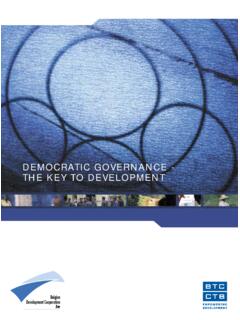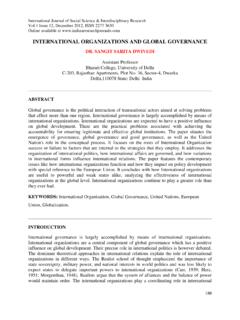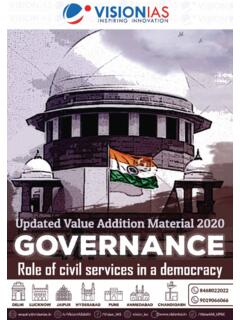Transcription of Civil Society Briefs: Philippines
1 Civil Society BRIEFS. Philippines . Country and Government Context Civil Society : An Overview The Republic of the Philippines is an archipelago The basis for Civil Society in the Philippines comes from the of more than 7,000 islands in Southeast Asia. Its Filipino concepts of pakikipagkapwa (holistic interaction with population in 2010 was estimated at 94 others) and kapwa (shared inner self). Voluntary assistance The country was a Spanish colony from 1521 to or charity connotes for Filipinos an equal status between the 1898. Following the Philippine Revolution, provider of assistance and the recipient, which is embodied independence was declared on 12 June 1898 in the terms damayan (assistance of peers in periods of crisis).
2 And the First Philippine Republic was established. and pagtutulungan (mutual self-help). The Western notion It was then claimed by the United States and, of kawanggawa (charity) may have been introduced to the after the Philippine American War (1899 1902), Philippines by Catholic became an American colony for nearly half a century. After a brief Japanese Occupation during World War II, the Philippines regained During the Spanish colonial period, the Roman Catholic independence on 4 July 1946. The country was Church and the religious orders established the first welfare placed under martial law from 1972 to 1981 organizations in the Philippines . They founded parochial schools, and formal political democracy was reestablished orphanages, and hospitals that were mostly reserved for the only after the 1986 People Power Revolution.
3 Local elite. The church also established foundations and cofrad as The president serves for a single 6-year term (brotherhoods), which encouraged neighborly behavior, such as and is chief executive, head of state, and visiting the sick and helping with town fiesta preparations. commander-in-chief. The country has a bicameral legislature a Senate with 24 members The American colonial government delineated the boundaries elected nationally and a 280-member House between state provision of public goods, religious philanthropy, of Representatives with district and party-list and private philanthropy. The Philippine Corporation Law representatives. The current president, Benigno S. Aquino III, was elected in May 2010. of 1906 recognized the right to create private nonprofit organizations, and the government subsidized the operation There are two official languages, Filipino and of some of these organizations.
4 The American Red Cross and English, as well as eight other major languages the Anti-Tuberculosis Society set up branches in the country. and about 80 lesser-spoken languages and The American Methodist and Protestant churches as well as the dialects. The Philippines is a lower-middle-income countryb with medium human development . Church of England established schools and hospitals. ranking in 112th (of 187 countries) in the world on the United Nations 2011 Human With support from the government, hundreds of farmer credit Development Index. cooperatives were created in the 1920s and 1930s, soon claiming more than 100,000 farmers as members. At the The adult literacy rate as of 2008 stands at for females and for males.
5 The same time, dissatisfaction among peasants fueled growth in poverty incidence as of 2009 is of the membership of the Congress of Labor Organizations, a labor population. Life expectancy at birth is 69 years federation linked to the communist movement. The communist for males and 74 years for females as of movement stimulated a counterreaction from the government, a Based on the 2000 Census on Population and Housing by religious organizations, and non-communist organizations. the Inter-Agency Working Group on Population Projections. The Catholic Church expanded its social agenda to direct b ADB. 2011. Country Partnership Strategy: Philippines , engagement with workers and peasants and the Jesuits. 2011 2016. Manila.
6 The country's per capita gross domestic product was $2,007 in 2010. Protestant and other non-Catholic churches expanded their c See note b. services into rural development, cooperatives, and credit unions or cooperatives, as well as agricultural development. Then-President Ferdinand Marcos declared martial law There are many types of CSOs in the country, but the in 1972 when there was little space for Civil Society more important types are people's organizations, and almost no tolerance for advocacy nongovernment development NGOs, and cooperatives. People's organizations (NGOs) during his rule. In areas where organizations are membership organizations the government bureaucracy could not deliver necessary representing marginalized groups and often organized social services, other development stakeholders, based on sector, issue, or geographical area.
7 Particularly NGOs, had to step into that role. However, Development NGOs act as intermediate agencies and some organizations either fled underground by joining institutions that typically operate with a full-time staff the armed struggle of the Communist Party of the complement and provide a wide range of services to Philippines , or sought shelter by affiliating with a primary organizations, communities, and individuals. university or religious institutions. During the Marcos A cooperative is an association of persons who dictatorship, many Civil Society organizations (CSOs) have voluntarily joined together to make equitable built up strong relationships with poor communities. contributions to the capital required, patronizing their The activism of CSOs eventually contributed to the products and services and accepting a fair share of the People Power Revolution of 1986 that ousted Marcos risks and benefits of the undertaking in accordance with and brought Corazon Aquino to power.
8 Universally accepted cooperative principles. 4. President Corazon Aquino restored democracy to the It is difficult to put a definite number to all the CSOs Philippines , and several pieces of legislation favorable in the country, partly because many are unregistered, to Civil Society 's development were passed soon after, but also because there is no single official and updated including the Cooperative Code of 1990 and the database on those that register with government Women in Development and Nation Building Act of agencies. In addition, studies that attempt to count Civil 1992. Government line agencies opened NGO liaison Society groups use various definitions and may therefore offices, and NGOs were permitted to negotiate directly include or exclude various types of CSOs.
9 However, with bilateral funding institutions for financing. Many one of the latest and most comprehensive studies puts in the Philippine development community began to the range of registered and non-registered CSOs at welcome CSO management of overseas development 249,000 497, It was estimated that 40% of these assistance (ODA) funds, recognizing CSOs as effective organizations were non-registered. channels for funneling support to needy communities. CSOs in the Philippines engage in a broad range of Owing to the favorable legal environment and the activities, the most common being in (i) education, inflow of ODA funds to the country, the number training, and human resource development;. of CSOs mushroomed during the administration of (ii) community development; (iii) enterprise President Aquino from 1986 to 1992.
10 The rapid growth development and employment generation; (iv) health of CSOs during the period may also be attributed to and nutrition; (v) law, advocacy, and politics; and the government's move to institutionalize Civil Society (vi) sustainable development. It is worth noting that participation in national and regional development political activism takes on a larger role for Filipino CSOs planning. However, in addition to those with good than elsewhere. Indeed, CSOs played major roles in intentions, organizations of dubious integrity achieving Filipino independence from the Spanish and engaged in questionable practices. Some of these the Americans, in toppling the Marcos regime, and in were established by politicians, businesspersons, and ending the administration of President Joseph Estrada.
















